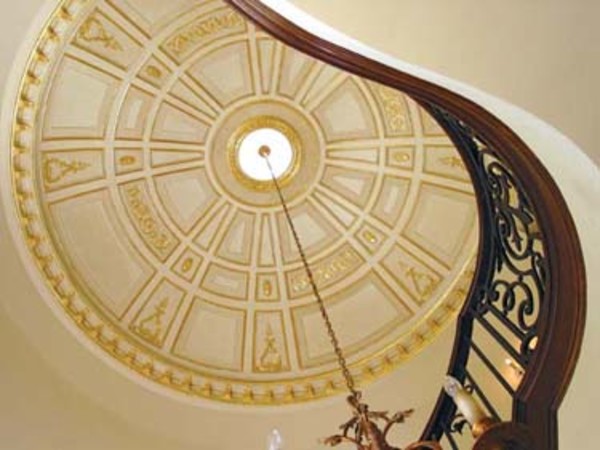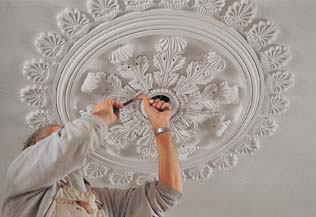
This dome ceiling is embellished with JP Weaver’s pliable “Petitsin” compo ornaments.
Last June, Catherine Lundie’s excellent overview of moldings and trim made readers hungry for ornament, but apparently begged some questions. “So—plaster is for the State House, and polyurethane is okay for spec houses—as long as you don’t look too close?” wrote one reader. Several others asked about cost, plain and simple: What’s the cheapest?
Plaster, the versatile and time-honored material, is for the State House (and museums, and the New York Public Library). But plaster is also for residential use. Medallions, moldings, and ornaments are readily available from the living archive of such companies as Decorator’s Supply in Chicago, and expert plasterers can be found to work on site.
Thinking of replacing your old plaster ceiling? Learn how to make easy plaster ceiling repairs instead.

Artistic installations, such as this ceiling center by sculptor and master artisan David Flaherty, are done in plaster. Brian McNeill photo
At any rate, it’s hard to make an apples-to-apples comparison among the various types of trim. In general, architectural ornament is surprisingly affordable; you’re paying for the nth cast, not for the original, hand-carved pattern. (A medium-size medallion in reinforced plaster, 16″ to about 25″ in diameter, runs from about $120 to $300 depending on complexity. Polyurethane medallions in that size category typically run from $35 to $140; they will not have the complexity or depth of relief of plaster.)
When it comes to installation, lightweight polyurethane ornament is easily a do-it-yourself job. Installation of, say, a precast plaster ceiling medallion is not complex, however.

Decorator’s Supply #750 is an exuberant Gothic 20″ plaster medallion.
Onlays, or small, three-dimensional ornaments, are usually made of compo, a traditional blend of oil, resin, and chalk or whiting in a glue matrix. These ornaments are made in almost infinite variety—not only dentils and egg-and-dart, but also Rococo carvings of musical instruments, Aesthetic dolphins, Greek corbels, designs by Sullivan and Wright, and geometric Art Deco motifs. Compo is also used for running trim. (Several companies offer highly flexible polyester trim that takes a radius and bridges uneven surfaces.)
Wood, Too
As traditional and versatile as plaster, wood can be cut or carved, and varnished, stained, or painted. It is specified when the element is structural as well as ornamental. Besides its use for columns and capitals, cornices, and wall moldings, wood is used for carved ornaments and onlays as well.
Over history, ornaments have been made of wood, compo, and plaster; it’s often hard to tell what the material is if it has been painted. Architectural woodcarvings are chosen for wood mantels and stairs, as repeat ornaments, and to decorate wood cabinets and furniture. Wood does shrink and swell, unlike plaster and hardened composition materials. Many installations require expert carpentry skills. But it is unquestionably the right choice for panels and wainscots, and for elements where color or grain are important.
Many of these companies offer ornament in Gothic, Deco, and even Modern vocabularies. Fine finish and proportion are the goals in the use of moldings, cornices, and ornamentation.
For ceiling ornament sources, see the Products & Services Directory.







